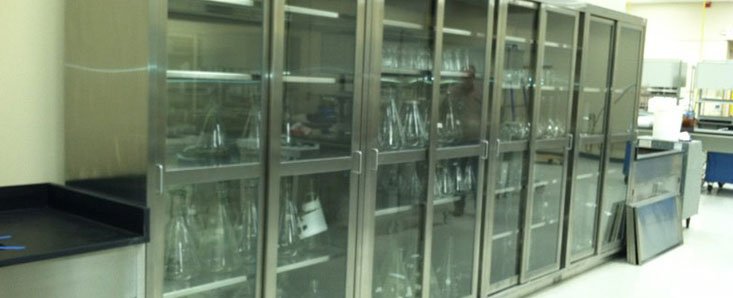Introduction to Stainless Steel
02.12.2019
Unlike iron, which has been in use for over a thousand years, stainless steel is a relative newcomer to the materials science world, having first been produced a little over 100 years ago. This may seem hard to believe at first, given the ubiquity of the metal in almost every facet of modern life, but this is simply a testament to what an important breakthrough stainless steel was. The metal has revolutionized the modern world and has found applications in almost every manufacturing sector, from healthcare and catering equipment, to the automotive and construction industries. Furthermore, it has out-performed more traditional competing materials such as copper, aluminium, and carbon steel.
The secret to the success of stainless steel lies in its incredible physical and chemical properties. Stainless steel has high corrosion resistance, heat resistance (of up to 1200°C [2192°F]), formability and weldability, durability, and does not rust. On top of this, the metal does not readily react to many substances, and is inexpensive compared to specialist, non-corrosive alloys. Over the past century, metallurgists have invented and improved methods to make stainless steels, control their properties, and mass-produce them with consistent quality.
The year 2013 marks the centenary of the invention of this remarkable metal, and in this article we take a brief look at the history of one of the most important breakthroughs in materials science.
Invention of Stainless Steel
In 1913, Harry Brearley of Sheffield, UK discovered ‘rustless’ steel. Although there had been many prior attempts, Brearley has been credited with inventing the first true stainless steel, which had a 12.8% chromium content. He had added chromium to molten iron to produce a metal that did not rust. Chromium is a key ingredient, as it provides the resistance to corrosion. After this discovery, Sheffield itself became synonymous with steel and metallurgy.
Brearley stumbled upon this discovery while trying to solve the problem of erosion of the internal surfaces of gun barrels for the British army during the onset of the First World War.
After the initial discovery, further improvements to stainless steel occurred at a fairly rapid pace. In 1919, Elwood Haynes obtained a patent on martensitic stainless steel, in 1929 William J. Kroll of Luxembourg was the first to discover precipitation-hardening stainless steel, and in 1930 duplex stainless steel was first produced in Sweden at the Avesta Ironworks.
Milestones in the History of Stainless Steel
The outstanding properties of stainless steel were gradually realized over the years, and below is a short timeline outlining some of the key moments in the history of stainless steel.
- Between the years 1919 and 1923, the use of stainless steel was adapted to the manufacturing of surgical scalpels, tools, and cutlery in Sheffield.
- In the early 1920s, a variety of chromium and nickel combinations were tested. Stainless steel was referred to as “18/8” to indicate the percentage of chromium and nickel in the steel.
- In 1925, a stainless steel tank was used to store nitric acid, thereby establishing the fact of this unique metal’s resistance to corrosion.
- In 1926, the first surgical implants made of stainless steel were performed.
- The hygienic aspect of the stainless steel was demonstrated in 1928 when the first stainless steel fermenting vessel was used to brew beer. Since then the food and beverage industry have widely used this metal.
- In the 1930s, the first stainless steel train was built in the USA.
- The year 1931 witnessed the creation of the first stainless steel aircraft.
- By 1935, stainless steel kitchen sinks were widely used.
- Type 430 stainless steel (ferritic chromium alloy) was used to make a wire 0.1mm in diameter for a voice-recording machine.
- In 1954, the first stainless steel underwater TV camera was manufactured.
- In 1966, the first tidal power station with stainless steel turbine blades was completed in France.
- In the 1980s, stainless steel was used to build the longest movable flood barrier in the world on the river Thames.
- Global production of stainless steel reached 31 million Mt in 2010.
- About 11 million washing machines with stainless steel drums were produced in 2010.
Over the last 100 years, about 100 grades of stainless steel have been discovered and made commercially available. These grades fall under four main family groups, namely, martenistic, ferritic, austentic, and duplex. Ferritic and martensitic stainless steels are magnetic while austenitic stainless steels are non-magnetic. These have varying quantities of other alloying metals like nickel, titanium, and copper, added to them. Carbon and nitrogen are also added to enhance the overall characteristics of stainless steel.
Stainless Steel Today
Stainless steel has found a myriad of applications from the tiniest structural parts in artificial heart valves to the largest architectural structures. Several world famous monuments, such as the Cloud Gate sculpture in Chicago, have been constructed using stainless steel.
With the growing awareness about the importance of reducing carbon emissions, many countries are keen on promoting stainless steel which is resistant to corrosion and has prolonged service life, therefore not requiring frequent replacements and repairs. Additionally, stainless steel is also 100% recyclable and does not degrade when reprocessed, thus allowing for multiple life cycles. The sustainability of stainless steel is unmatched compared to other metals.













